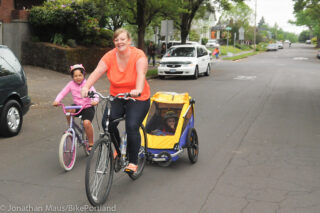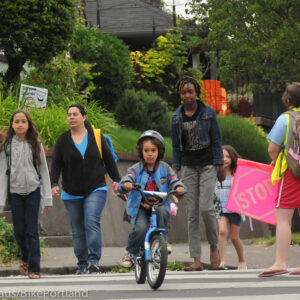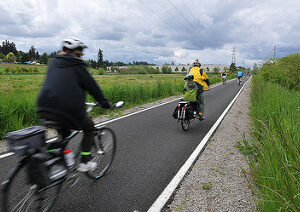
(Photo: J. Maus)
One of the bright spots in the $5.3 billion transportation package passed by the Oregon Legislature in 2017 was annual funding dedicated to Safe Routes to School.
House Bill 2017 (which the Oregon Department of Transportation now calls the Keep Oregon Moving program), included a $10 million annual investment in street safety projects within a one-mile radius of schools. That number bumps up to $15 million a year in 2023.
But when the ink on the bill dried, there remained a lot of things to figure out. Who would be eligible for the money? What would the grant process look like? Which type of roads and projects would compete best for the funds?
To answer these and other questions, ODOT convened a Safe Routes to School Rulemaking Advisory Committee. The bulk of that committee’s work is done and yesterday ODOT announced that the draft rule update for the new Safe Routes to School Fund is ready for public scrutiny.
“We’ve heard from many communities that the high cash match requirement is a deterrent, and we hope to see a legislative fix to this unnecessary hurdle.”
— Kari Schlosshauer, Safe Routes to School National Partnership Senior Policy Manager
The proposed rule divides the Fund into three grant programs: Competitive, Rapid Response, and Project Identification. The Competitive grant program will use 87.5 percent or more of the total available funds and will go toward building street safety projects, “to reduce barriers and hazards for children walking or bicycling to or from schools.” Up to 10 percent of the fund will go toward Rapid Response projects to be used, “for urgent needs or systemic safety issues that occur in between Competitive Program Grant cycles.” And the 2.5 percent of the funds set aside for Project Identification grants will be used by ODOT staff to help community select eligible projects.
Another important function of the rulemaking process is to clarify definitions of words and phrases used in the rule so that grant seekers and ODOT speak the same language. The most noteworthy of these is that the committee has defined “priority safety corridor” as having:
Either the posted or 85th percentile speed is 40 miles per hour or greater; or two or more of the following exist: Speed limit 30 miles per hour or greater; More than two lanes or a crossing distance greater than 30 feet; 12,000 or greater annual average daily traffic; Has a demonstrated history of crashes related to school traffic.
With such a specific definition, there are many potential projects on streets that won’t meet those standards. If an applicant proposes a project that’s not on a “priority safety corridor,” the project might still be elibile, “if the applicant can demonstrate a significant safety risk through data or research.”
As for who’s eligible for funding, the rule clarifies that grant applications can be submitted by cities, counties, ODOT, tribes, and transit agencies. The projects must be either already listed in a planning document and/or supported by the school district.
Advertisement
Note that ODOT itself is eligible to receive funding through this program. That could make for an awkward selection process when ODOT is competing with local agencies for funding. That’s something for advocates to keep an eye on.
The be considered for selection, a project must, “Provide safety improvements that reduce barriers and hazards to children walking or bicycling to and from school.” Project types can include (but are not limited to), “creation of or improvements to sidewalks or bicycle lanes, reductions in vehicle speeds, and improvements to pedestrian and bicycle crossings.”
An unfortunate part of the sausage-making from the 2017 legislative session resulted in a stipulation applicants must provide a cash match of at least 40 percent of the project’s cost. That’s a big chunk of change that’s liable to prevent some entities from participating. Thankfully the rule includes a provision that will reduce the match to 20 percent if a school is in a city with fewer than 5,000 people, if the project reduces hazards within a priority safety corridor, or if the school qualifies for Title I treatment.
Asking for local agencies to pony up precious dollars to keep kids safe while walking and biking to school isn’t a good luck for an agency willing to throw billions of dollars at unneccessary highway expansion mega-projects. The cash match requirements concerned both of the Safe Routes advocates who shared their thoughts with us about the new rule.
Safe Routes to School National Partnership Senior Policy Manager Kari Schlosshauer is on the rulemaking advisory committee. She told us her organization is excited to see dedicated funding for Safe Routes and they’re focused on making sure it gets to the schools with the least amount of existing resources. “Unfortunately,” Schlosshauer added. “We’ve heard from many communities that the high cash match requirement is a deterrent, and we hope to see a legislative fix to this unnecessary hurdle.”
The Street Trust Advocacy Director Gerik Kransky echoed that sentiment. “We remain concerned about the high match requirements of the new program,” he shared with us via email yesterday. “And while we won’t be able to address those concerns through rulemaking we will be creating a strong public record on the issue so we can continue our campaign to expand and improve Oregon’s new SRTS infrastructure program by making it more accessible in low income communities that need it most.”
ODOT will accept public comments on the draft rule from May 1 – 31. You can send them to Safe Routes to School Program Manager LeeAnne Fergason via email at LeeAnne.FERGASON [at] odot.state.or.us. A public hearing will take place in Salem on May 15th, the Oregon Transportation Commission will consider the rule at their meeting on July 19th, and barring an unforeseen hurdles, the new rules would go into effect on July 23rd.
If you plan to solicit funding through these new grant programs, ODOT is hosting a series of workshops around the state starting in June. The Portland region workshop will take place on July 2nd. See the full list here.
Other helpful documents:
–> Safe Routes to School Fund: Overview of Draft Rule Update (PDF)
–> Notice of Proposed Rulemaking (PDF)
— Jonathan Maus: (503) 706-8804, @jonathan_maus on Twitter and jonathan@bikeportland.org
Never miss a story. Sign-up for the daily BP Headlines email.
BikePortland needs your support.






Thanks for reading.
BikePortland has served this community with independent community journalism since 2005. We rely on subscriptions from readers like you to survive. Your financial support is vital in keeping this valuable resource alive and well.
Please subscribe today to strengthen and expand our work.
Between taking out the Flint Ave. bridge and removal of the SE 26th bike lane they must be feel pretty good about their prospects these day, but AFAIAC ODOT can go f*** themselves, I spent some time looking at the traffic at Broadway and Vancouver this evening, and if ODOT thinks this is an alternative to the Flint Ave. crossing they really, really have their heads stuck in a very dark place. Putting ODOT in charge of any funds or rulemaking for safe routes to schools gives me all kinds of very bad feelings.
The first thing that needs to be done is take ODOT completely out of the schools thing. An even better solution would be to completely remove any street, road, or highway that is adjacent to a school or through a school district from jurisdiction to that street or road.
Sound familiar Cleveland with Powell? and north Portland with Columbia Boulivard?
ODOT doesn’t have jurisdiction over Columbia Blvd. PBOT does.
And, schools are State agencies, with their own budget issues, so relocating schools in built up areas is usually out of the question.
And, school transportation budgets sometimes come with strings attached (like paying for buses is ok, but bike lanes is not).
And, Federal transportation funds always have strings attached, like State DOTs managing the distribution of those funds.
At least the current siting guidelines have improved:
https://www.epa.gov/sites/production/files/2015-06/documents/school_siting_guidelines-2.pdf
In early 70s when almost half of children walked or bike to school a 1 mile radius made sense. Now decades of under-funding and school consolidation have made the average distance a child lives from school much higher. The radius should be increased to 2 miles.